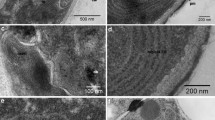Summary
The appearance and spatial distrubution of ultrastructural markers ofDictyostelium discoideum differentiation were quantitatively analysed. Our results combined with data from the literature on the functions of cells at various stages of development lead to the following conclusions. When food is no longer available all amoebae initially develop an autophagic apparatus in order to sustain metabolism. After slugs have been formed, autophagy is suppressed in the prespore cells. During aggregation a number of cells gradually form prespore characteristics. These cells arise at random but later they become located in the basal part of the tip-forming aggregate. From the early slug stage onwards, cells of the posterior two third region gradually enter into the prespore pathway. During prolonged slug migration the optimal acquirement of prespore characteristics is blocked. Cells of the anterior region show no active differentiation but they maintain the morphology and most of the functions of aggregating cells. At the rear-guard of the slug and later on in the basal region of the maturing fruiting body, a second anteriorlike region appears. Actual stalk cell differentiation takes place only at the apex and at the base of the developing fruiting body.
Similar content being viewed by others
References
Bonner JT (1967) The cellular slime molds. Princeton University Press, Princeton, New Jersey
Bonner JT, Chiquoine AD, Kolderie MQ (1955) A histochemical study of differentiation in the cellular slime molds. J Ezp Zool 130:133–157
Brenner M (1977) Cyclic AMP gradient in migrating pseudoplasmodia of the cellular slime moldDictyostelium discoideum. J Biol Chem 252:4073–4077
Brown SS, Rutherford CL (1980) Localization of cyclic nucleotide phosphodiesterase in the multicellular stages ofDictyostelium discoideum. Differentiation 16:173–183
Durston AJ (1976) Tip formation is inhibited by an inhibitory gradient in theDictyostelium discoideum slug. Nature 263:126–129
Durston AJ, Vork F (1979) A einematographical study of the development of vitally stainedDictyostelium discoideum. J Cell Sci 36:261–279
George RP, Hohl HR, Raper KB (1972) Ultrastructural development of stalk-producing cells inDictyostelium discoideum, a cellular slime mould. J Gen Microbiol 70:477–489
Gregg JH, Karp GC (1978) Patterns of cell differentiation revealed by L-(3H) fucose incorporation inDictyostelium. Exp Cell Res 112:31–46
Gregg JH, Davis RW (1982) Dynamics of cell redifferentiation inDictyostelium. Differentiation 21:200–205
Gross JD, Town CD, Brookman JJ, Jermyn KA, Peacey MJ, Kay RR (1981) Cell patterning inDictyostelium. Phil Trans R Soc (Lond) 295:497–508
Hamilton ID, Chia WK (1975) Enzyme activity changes during cyclic AMP-induced stalk cell differentiation in p4, a variant ofDictyostelium discoideum. J Gen Microbiol 91:295–306
Hayashi M, Takeuchi I (1976) Quantitative studies on cell differentiation during morphogenesis of the cellular slime moldDictyostelium discoideum. Dev Biol 50:302–309
Ikeda T, Takeuchi I (1971) Isolation and characterization of a prespore specific structure of the cellular slime mold,Dictyostelium discoideum. Dev Growth Diff 13:221–229
Inouye K, Takeuchi I (1980) Motive force of the migrating pseudoplasmodium of the cellular slime mouldDictyostelium discoideum. J Cell Sci 41:53–64
Kopachik W (1982) Size regulation inDictyostelium. J Embryol Exp Morphol 68:23–35
MacWilliams HK, Bonner JT (1979) The prestalk-prespore pattern in cellular slime molds. Differentiation 14:1–22
Maeda Y, Maeda M (1974) Heterogeneity of the cell population of the cellular slime moldDictyostelium discoideum before aggregation and its relation to the subsequent locations of the cells Exp Cell Res 84:88–94
McMahon D (1981) Cell interactions and pattern formation inDictyostelium discoideum. In “Recent advances in Phytochemistry” 15:259–272
Müller U, Hohl HR (1973) Pattern formation inDictyostelium discoideum: Temporal and spatial distribution of prespore vacuoles. Differentiation 1:267–276
Newell PC, Sussman M (1970) Regulation of enzyme synthesis by slime mold cell assemblies embarked upon alternative developmental programs. J Mol Biol 49:627–637
Newell PC, Ellingson JS, Sussman M (1969) Synchrony of enzyme accumulation in a population of differentiating slime mold cells. Biochim Biophys Acta 177:610–614
Oohata A (1976) Changes in β-galactosidase activity during differentiation and dedifferentiation inDictyostelium discoideum. Bot Mag (Tokyo) 89:115–122
Oohata A, Takeuchi I (1977) Separation and biochemical characterization of the two cell types present in the pseudoplasmodium ofDictyostelium mucoroides. J Cell Sci 24:1–9
Pan P, Bonner JT, Wedner HJ, Parker CW (1974) Immunofluorescence evidence for the distribution of cyclic AMP in cells and cell masses of the cellular slime molds. Proc Natl Acad Sci USA 5:1623–1625
Quiviger B, Benichou JC, Ryter A (1980) Comparative cytochemical localization of alkaline and acid phosphatases during starvation and differentiation ofDictyostelium, discoideum. Biol Cell 37:241–250
Rubin J (1976) The signal from fruiting body and conus tips ofDictyostelium discoideum. J Embryol Exp Morphol 36:261–271
Schaap P, Van der Molen L, Konijn TM (1982) Early recosnition of prespore differentiation inDictyostelium discoideum and its significance for models on pattern formation. Differentiation 22:1–5
Sharpe PT, Treffry TE, Watts DJ (1982) Studies of early stages of differentiation of the cellular slime mouldDictyostelium discoideum. J Embryol Exp Morphol 67:181–193
Sternfeld J, David CN, (1981), Cell sorting during pattern formation inDictyostelium. Differentiation 20:10–21
Takeuchi I (1963) Immunochemical and immunohistochemical studies on the development of the cellular slime moldDictyostelium mucoroides. Dev Biol 8:1–26
Takeuchi I (1969) Establishment of polar organization during slime mold development. In: Cowdry EV, Seno S (eds) Nucleic acid metabolism, cell differentiation and cancer growth. Pergamon Press, Oxford New York, pp 297–304
Takeuchi I, Hayashi M, Tasaka M (1977) Cell differentiation and pattern formation inDictyostelium. In: Cappuccinelli P, Ashworth JM (eds) Developments and differentiation in the cellular slime molds. Elsevier/North Holland Biomedical, Press, Amsterdam, pp 1–16
Tasaka M, Takeuchi I (1981) Role of cell sorting in pattern formation inDictyostelium discoideum. Differentiation 18:191–196
Yamamoto A, Maeda Y, Takeuchi I (1981) Development of an autophagic system in differentiating cells of the cellular slime moldDictyostelium discoideum. Protoplasma 108:55–69
Weibel ER, Elias H (1967) Quantitative methods in morphology. Springer, Berlin Heidelberg New York
Author information
Authors and Affiliations
Rights and permissions
About this article
Cite this article
Schaap, P. Quantitative analysis of the spatial distribution of ultrastructural differentiation markers during development ofDictyostelium discoideum . Wilhelm Roux' Archiv 192, 86–94 (1983). https://doi.org/10.1007/BF00848484
Received:
Accepted:
Issue Date:
DOI: https://doi.org/10.1007/BF00848484




